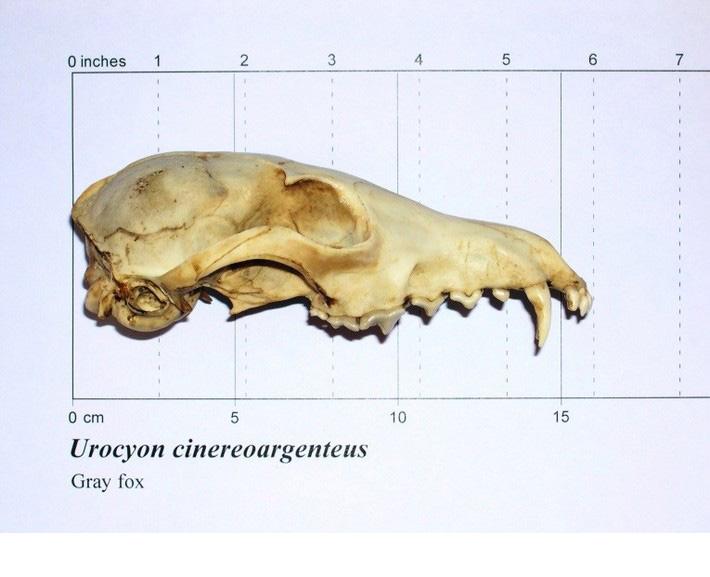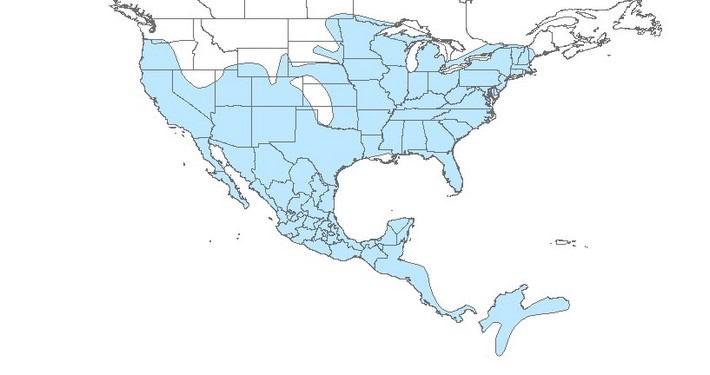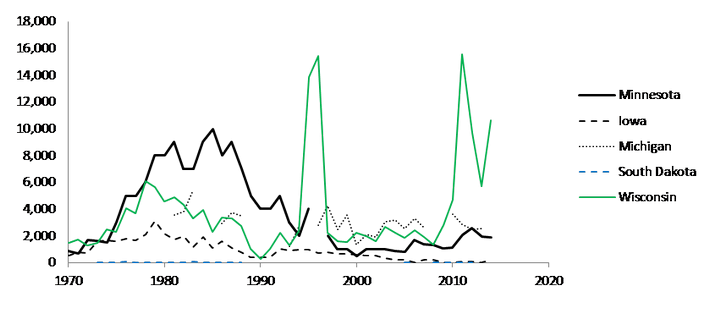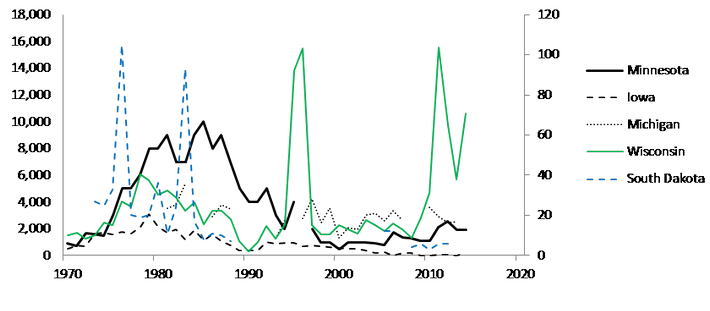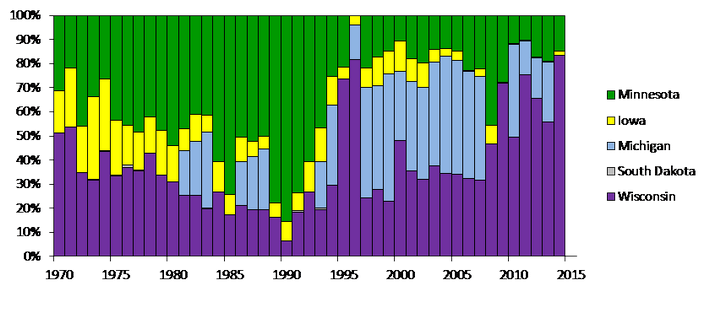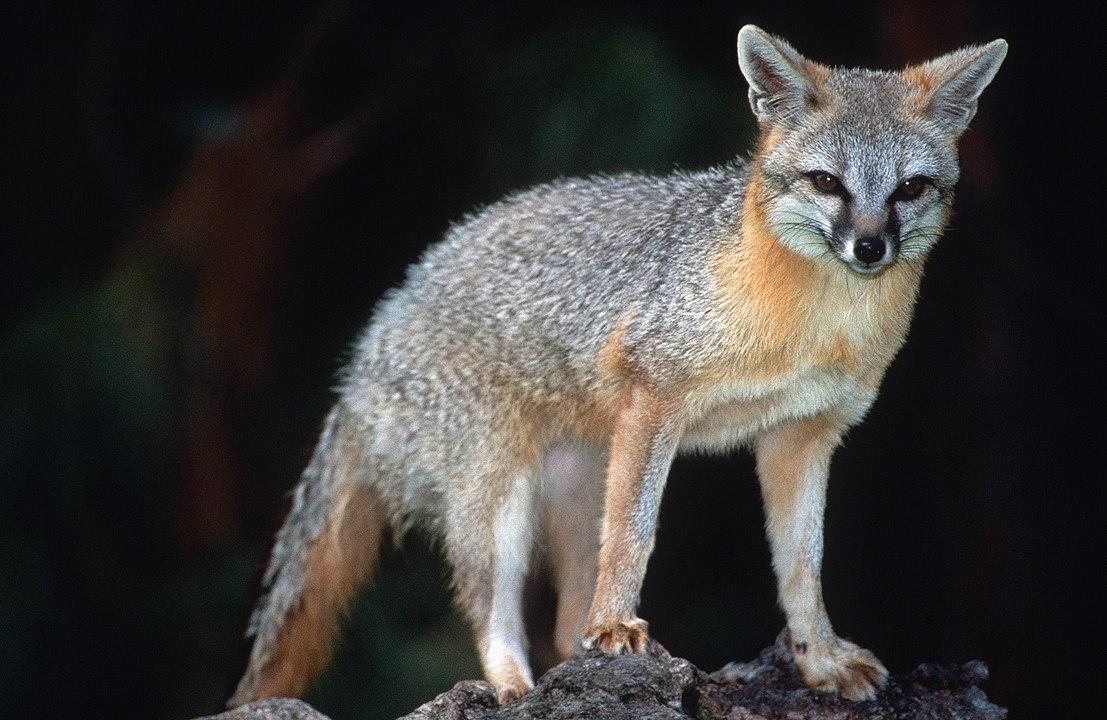
Description
Gray foxes are medium-sized carnivores in the dog family (Canidae). The major identification challenge is distinguishing gray foxes from red foxes.
Red foxes have white tail tips, throats, and underfur, while gray foxes have black tail tips and yellow or orange coloration on a white throat/underfur. Red foxes tend to be slightly heavier than gray foxes, and red foxes have slightly longer muzzles than gray foxes. A few red foxes are black or silver in coloration, which reflects normal genetic variation within the species.
Size
Measurements from Minnesota are from Hazard (1982), from Wisconsin are from Jackson (1961), and from the Eastern United States are from Hamilton and Whitaker (1998).
Total length ranged from 35.6” to 40.9” (905-1040 mm) in Minnesota, 31.7” to 41.9” (805-1065 mm) in the Eastern United States, and 37.4” to 40.9” (950-1040 mm) in Wisconsin.
Tail length ranged from 11.5” to 14.9” (293-378 mm) in Minnesota, 8.7” to 17.6” (220-448 mm) in the Eastern United States, and 12.2” to 15.4” (310-390 mm) in Wisconsin.
Body weight ranged from 8.4 to 11.5 lb (3.8-5.2 kg) in Minnesota, 7.1 to 13.0 lb (3.2-5.9 kg) in the Eastern United States, and 9.9 to 13.9 lb (4.5-6.3 kg) in Wisconsin.
Males tend to be slightly larger than females, but individuals of both sexes fall into the same length and weight ranges.
Distribution & Status
Gray foxes are found locally in extreme southern Canada, in much of the continental U.S. and Mexico, south to northern South America. Gray foxes are absent from portions of the western United States west of Minnesota. Regionally, gray foxes are more common in Michigan, Wisconsin, and Minnesota than in other Great Lakes states. Populations are threatened in Ontario.
Worldwide, Urocyon cinereoargenteus is restricted to North America, Central America, and the northwest corner of South America. Urocyon littoralis, the only other species in the genus, is restricted to the Channel Islands off the southern coast of California.
Gray foxes have an IUCN rank of Least Concern: IUCN information
Incidence in Minnesota
Trapping for foxes, raccoons, badgers, and opossums are jointly administered in Minnesota, typically allowed during a period from fall through winter. In 2017-8, open season will be from October 14th through March 15th. Hunting and trapping are regulated by the Minnesota Department of Natural Resources, regulations here
Population Trends
To help assess population trends, we can look at regional furbearer harvest data, methods here.
Generally, regional harvest was highest from the mid-1970s until the late 1980s. Since the late 1980s, harvest levels have plummeted, except for a couple of harvest spike years in Wisconsin.
Minnesota, Wisconsin, and Michigan dominate regional harvest.
Life History
Gray foxes eat a variety of small mammals, birds, fruits, and insects. Gray foxes mate in February and March, with 3-7 pups born after a 53 day gestation. Eyes open 9 days after birth, and pups are able to eat solid food at 3 weeks. Gray fox dens can be in wood piles, rock outcrops, hollow trees, or brushpiles. Pups may not disperse until January or February, though family bonds weaken in late summer. Adults are sexually mature by 1 year old. Gray foxes will climb trees as refuge and to obtain food. Canine distemper has caused large die-offs locally (IUCN, 2017), and gray foxes can also be affected by rabies and canine parovirus. Gray foxes are occasional prey of larger mammal predators and raptors.
Contacts with Humans
Foxes are sometimes trapped for fur, but red fox pelts are more valuable than gray fox pelts. Gray foxes will climb trees when threatened, so are not pursued in traditional fox hunts with hounds and horses. Gray foxes prefer wooded habitat, so are less likely than red foxes to impact poultry operations. Gray foxes help curb small mammal populations.

